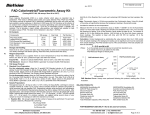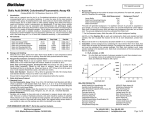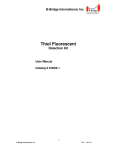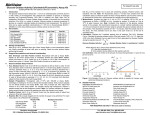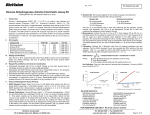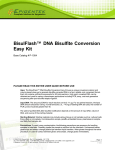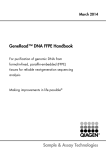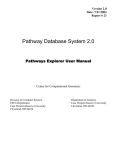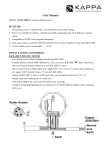Download Data Sheet - BioVision
Transcript
BioVision rev. 02/13 Branched Chain Amino Acid (Leu, Ile, Val) Colorimetric Assay Kit ° (Catalog #K564-100; 100 Reactions; Store kit at –20 C) I. Introduction: The branched-chain amino acids or BCAA’s, refer to the amino acids with non-linear aliphatic side-chains, namely leucine, isoleucine and valine. These three essential amino acids make up approximately 1/3 of skeletal muscle in the human body. BCAA’s are currently used clinically to aid in the recovery of burn victims, as well as for strength supplementation for athletes. BCAA’s, primarily Leu, can stimulate insulin secretion. The BCAA’s have also been implicated in a wide range of other physiological effects. BioVision's BCAA Assay Kit provides a simple convenient means of measuring the BCAA’s in a variety of biological samples. The kit utilizes an enzyme assay in which BCAA is oxidatively deaminated, producing NADH which reduces the probe, generating a colored product (λmax = 450 nm). BioVision’s BCAA kit measures BCAA’s in the range of 0 to 10 nmol per sample with a detection limit of ~0.2 nmol (~10 µM BCAA in sample). BCAA’s are present in serum ~ 0.1-0.4 mM each (~0.125-1.5 mM combined). II. Kit Contents: III. Components K564-100 Cap Code Part No. BCAA Assay Buffer BCAA Enzyme Mix WST Substrate Mix Leu Standard (1 µmol) 25 ml lyophilized lyophilized 100 µl WM Green Red Yellow K564-100-1 K564-100-2 K564-100-3 K564-100-4 For research use only 3. Reaction Mix: Mix enough reagents for the number of assays to be performed. For each well, prepare a total 50 µl Reaction Mix containing: Amino Acid Measurement Bkgd Control Assay Buffer 46 µl 48 µl Enzyme Mix 2 µl ----WST Substrate Mix 2 µl 2 µl Add 50 µl of the Reaction Mix to each well containing the leucine standard and test samples. Mix well. Incubate the reaction for 30 min at room temperature, protect from light. NADH and NADPH can generate significant background. If these compounds are suspected of being in your sample at significant concentration, perform a simple background control by replacing the Enzyme Mix with 2 µl Assay Buffer. The background reading should be subtracted from the BCAA test sample readings. 4. Measure O.D. at 450 nm in a microplate reader 5. Calculation: Correct background by subtracting the value derived from the 0 BCAA standards from all readings (The background reading can be significant and must be subtracted from sample readings). Plot standard curve. Apply sample readings to the standard curve. BCAA concentrations of the test samples can then be calculated: µl, or mM) C = Sa/Sv (nmol/µ Where: Sa = BCAA content of unknown samples (nmol) from standard curve, Sv = sample volume (µl) added into the assay wells. BCAA molecular weights are: Leu 131.18, Ile 131.18, Val 117.15 g/mol. Storage and Handling: Store the kit at -20°C, protect from light. Allow Assay Buffer to warm to room temperature before use. Briefly centrifuge vials prior to opening. Read the entire protocol before performing the assay. IV. Reagent Reconstitution and General Consideration: BCAA Enzyme Mix: Dissolve with 220 µl BCAA Assay Buffer. Pipette up and down to dissolve. Stable at 4°C for two months. WST Substrate Mix: Dissolve with 220 µl of dH2O before use. Mix well, store at 4°C, protect from light. Stable for 2 months. Leucine Standard: Ready to use as supplied. Store at 4°C. V. BCAA Assay Protocol: 1. Standard Curve: Dilute 10 µl of the 10 mM Leucine Standard with 90 µl dH2O to generate 1 mM Leucine standard. Add 0, 2, 4, 6, 8, 10 µl of the diluted Standard into a 96-well plate to generate 0, 2, 4, 6, 8, 10 nmol/well standard. Bring the volume to 50 µl with Assay Buffer. 2. Sample Preparation: Tissue (20 mg) or cells (2 x 106) can be homogenized with 100 µl Assay buffer. Centrifuge at 15,000g for 10 minutes to remove cell debris and other insoluble materials. Add samples to sample wells in a 96-well plate and bring the volume to 50 µl/well with Assay Buffer. We suggest testing several doses of your sample to make sure the readings are within the standard curve range. Typical volume for serum samples should be in the range of 1 – 20 µl. BioVision Incorporated 155 S. Milpitas Boulevard, Milpitas, CA 95035 USA Leucine Assay performed according to this protocol RELATED PRODUCTS: NAD(P)/NAD(P)H Quantification Kit Ascorbic Acid Quantification Kit Total Antioxidant Capacity (TAC) Assay Kit Ethanol Assay Kit Pyruvate Assay Kit Creatinine Assay Kit Ammonia Assay Kit Triglyceride Assay Kit Alanine Assay Kit Sarcosine Assay Kit Phenylalanine Assay Kit ADP/ATP Ratio Assay Kit Glutathione Detection Kit Fatty Acid Assay Kit Uric Acid Assay Kit Lactate Assay Kit I & II Nitric Oxide Assay Kit Free Glycerol Assay Kit Hemin Assay Kit Glucose Assay Kit L-Amino Acid Assay Kit Cholesterol Assay Kit FOR RESEARCH USE ONLY! Not to be used on humans. Tel: 408-493-1800 | Fax: 408-493-1801 www.biovision.com | [email protected] Page 1 of 2 BioVision rev. 02/13 For research use only GENERAL TROUBLESHOOTING GUIDE: Problems Cause Solution Assay not working • Use of ice-cold assay buffer • Assay buffer must be at room temperature Samples with erratic readings Lower/ Higher readings in Samples and Standards Readings do not follow a linear pattern for Standard curve Unanticipated results • Omission of a step in the protocol • Refer and follow the data sheet precisely • Plate read at incorrect wavelength • Check the wavelength in the data sheet and the filter settings of the instrument • Use of a different 96-well plate • Fluorescence: Black plates ; Luminescence: White plates ; Colorimeters: Clear plates • Use of an incompatible sample type • Refer data sheet for details about incompatible samples • Samples prepared in a different buffer • Use the assay buffer provided in the kit or refer data sheet for instructions • Samples were not deproteinized (if indicated in datasheet) • Use the 10 kDa spin cut-off filter or PCA precipitation as indicated • Cell/ tissue samples were not completely homogenized • Use Dounce homogenizer (increase the number of strokes); observe for lysis under microscope • Samples used after multiple free-thaw cycles • Aliquot and freeze samples if needed to use multiple times • Presence of interfering substance in the sample • Troubleshoot if needed, deproteinize samples • Use of old or inappropriately stored samples • Use fresh samples or store at correct temperatures till use • Improperly thawed components • Thaw all components completely and mix gently before use • Use of expired kit or improperly stored reagents • Always check the expiry date and store the components appropriately • Allowing the reagents to sit for extended times on ice • Always thaw and prepare fresh reaction mix before use • Incorrect incubation times or temperatures • Refer datasheet & verify correct incubation times and temperatures • Incorrect volumes used • Use calibrated pipettes and aliquot correctly • Use of partially thawed components • Thaw and resuspend all components before preparing the reaction mix • Pipetting errors in the standard • Avoid pipetting small volumes • Pipetting errors in the reaction mix • Prepare a master reaction mix whenever possible • Air bubbles formed in well • Pipette gently against the wall of the tubes • Standard stock is at an incorrect concentration • Always refer the dilutions in the data sheet • Calculation errors • Recheck calculations after referring the data sheet • Substituting reagents from older kits/ lots • Use fresh components from the same kit • Measured at incorrect wavelength • Check the equipment and the filter setting • Samples contain interfering substances • Troubleshoot if it interferes with the kit • Use of incompatible sample type • Refer data sheet to check if sample is compatible with the kit or optimization is needed • Sample readings above/below the linear range • Concentrate/ Dilute sample so as to be in the linear range Note: The most probable list of causes is under each problem section. Causes/ Solutions may overlap with other problems. BioVision Incorporated 155 S. Milpitas Boulevard, Milpitas, CA 95035 USA Tel: 408-493-1800 | Fax: 408-493-1801 www.biovision.com | [email protected] Page 2 of 2


